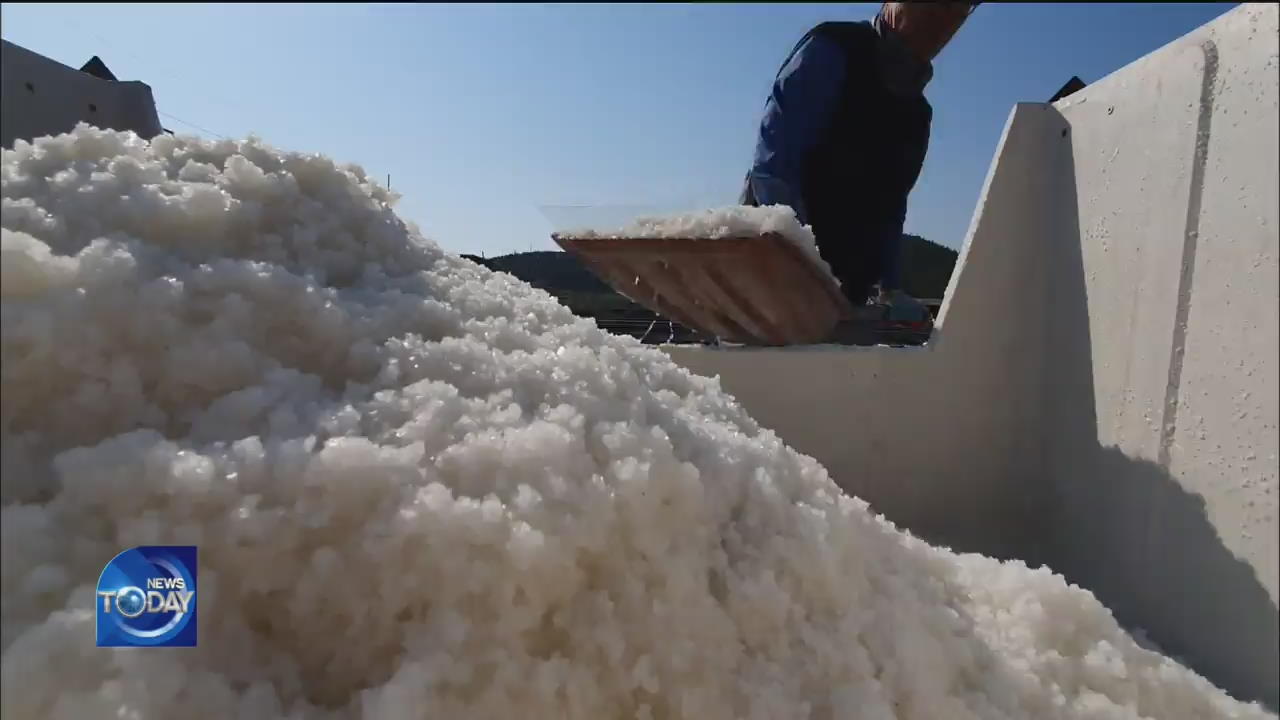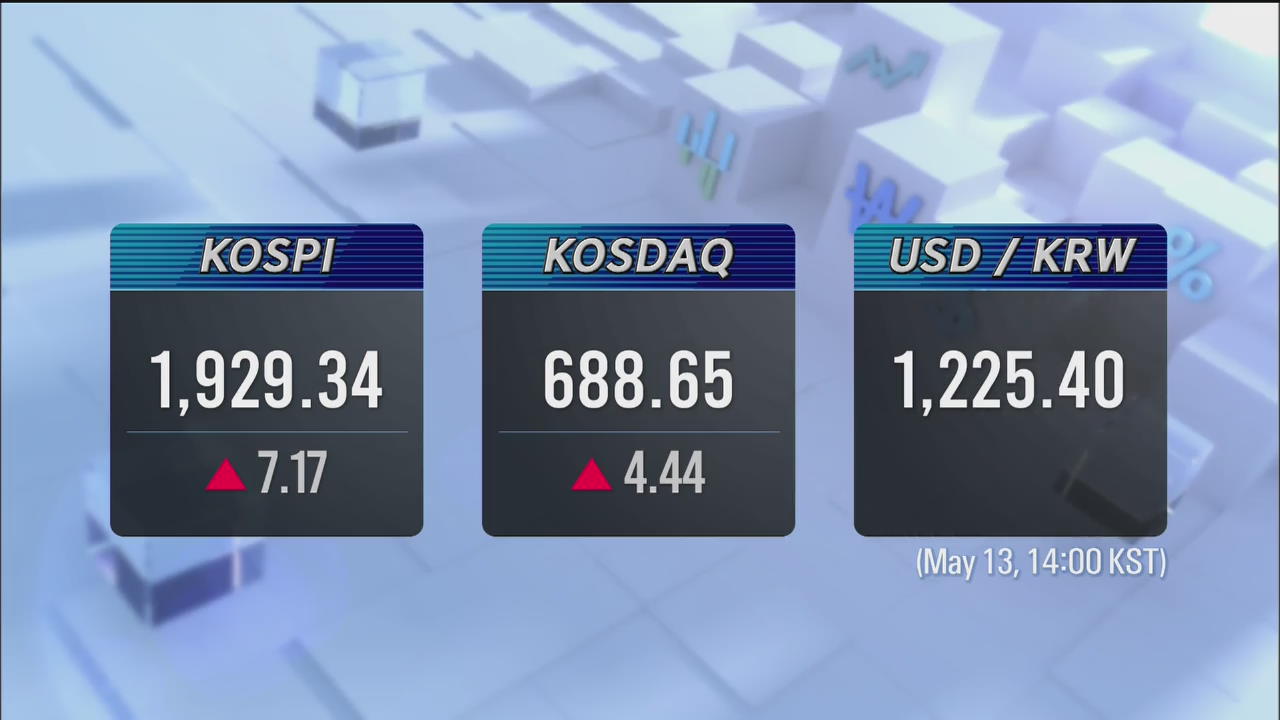PINE POLLEN WELCOMED IN SALT FARMS
입력 2020.05.13 (15:35)
수정 2020.05.13 (16:46)
읽어주기 기능은 크롬기반의
브라우저에서만 사용하실 수 있습니다.
[Anchor Lead]
Pine pollen causes a lot of trouble to drivers during this time of year as it lands on car windows becoming a hassle to clean it off. But at salt farms on Korea's west coast, pine pollen is a welcome guest. Here's why.
[Pkg]
A vast salt farm on Taean Peninsula.., Patches of yellowish powder can be seen all over the farm. It's none other than pine pollen. When mixed with bay salt, pine pollen gives it a yellowish tint. This is how the pine pollen salt, a rare kind of sea salt, is made.
[Soundbite] SONG HYUN-SEOP(OWNER OF SALT FARM) : "My farm is surrounded by pine trees on three sides. We have a lot of pine pollen for about a week. Salt mixed with pine pollen tastes good."
Home to 90 percent of pine trees, Taean has ideal conditions for producing pine pollen salt. It is difficult to produce because it can only be collected for about ten days during this time of year, when pine pollen is produced, and because the right weather factors are needed for it, such as sunshine and wind. Pine pollen salt is produced in small amounts and is regarded as a premium sea salt. This year, its production declined by 30 percent due to frequent rainfall during the harvest season. Although it costs three to four times more than regular salt, pine pollen salt not only tastes good but is also rich in calcium, vitamins and minerals, thus offering multiple health benefits.
[Soundbite] HANG JUNG-SEON(CULINARY EXPERT) : "Pine pollen salt contains choline, which gives it a mild and sweet taste. It can be used in pickled cucumbers and radish kimchi."
Pine pollen may be an annoying spring visitor in urban areas, but is a welcome guest at sea salt farms.
Pine pollen causes a lot of trouble to drivers during this time of year as it lands on car windows becoming a hassle to clean it off. But at salt farms on Korea's west coast, pine pollen is a welcome guest. Here's why.
[Pkg]
A vast salt farm on Taean Peninsula.., Patches of yellowish powder can be seen all over the farm. It's none other than pine pollen. When mixed with bay salt, pine pollen gives it a yellowish tint. This is how the pine pollen salt, a rare kind of sea salt, is made.
[Soundbite] SONG HYUN-SEOP(OWNER OF SALT FARM) : "My farm is surrounded by pine trees on three sides. We have a lot of pine pollen for about a week. Salt mixed with pine pollen tastes good."
Home to 90 percent of pine trees, Taean has ideal conditions for producing pine pollen salt. It is difficult to produce because it can only be collected for about ten days during this time of year, when pine pollen is produced, and because the right weather factors are needed for it, such as sunshine and wind. Pine pollen salt is produced in small amounts and is regarded as a premium sea salt. This year, its production declined by 30 percent due to frequent rainfall during the harvest season. Although it costs three to four times more than regular salt, pine pollen salt not only tastes good but is also rich in calcium, vitamins and minerals, thus offering multiple health benefits.
[Soundbite] HANG JUNG-SEON(CULINARY EXPERT) : "Pine pollen salt contains choline, which gives it a mild and sweet taste. It can be used in pickled cucumbers and radish kimchi."
Pine pollen may be an annoying spring visitor in urban areas, but is a welcome guest at sea salt farms.
■ 제보하기
▷ 카카오톡 : 'KBS제보' 검색, 채널 추가
▷ 전화 : 02-781-1234, 4444
▷ 이메일 : kbs1234@kbs.co.kr
▷ 유튜브, 네이버, 카카오에서도 KBS뉴스를 구독해주세요!
- PINE POLLEN WELCOMED IN SALT FARMS
-
- 입력 2020-05-13 15:37:15
- 수정2020-05-13 16:46:26

[Anchor Lead]
Pine pollen causes a lot of trouble to drivers during this time of year as it lands on car windows becoming a hassle to clean it off. But at salt farms on Korea's west coast, pine pollen is a welcome guest. Here's why.
[Pkg]
A vast salt farm on Taean Peninsula.., Patches of yellowish powder can be seen all over the farm. It's none other than pine pollen. When mixed with bay salt, pine pollen gives it a yellowish tint. This is how the pine pollen salt, a rare kind of sea salt, is made.
[Soundbite] SONG HYUN-SEOP(OWNER OF SALT FARM) : "My farm is surrounded by pine trees on three sides. We have a lot of pine pollen for about a week. Salt mixed with pine pollen tastes good."
Home to 90 percent of pine trees, Taean has ideal conditions for producing pine pollen salt. It is difficult to produce because it can only be collected for about ten days during this time of year, when pine pollen is produced, and because the right weather factors are needed for it, such as sunshine and wind. Pine pollen salt is produced in small amounts and is regarded as a premium sea salt. This year, its production declined by 30 percent due to frequent rainfall during the harvest season. Although it costs three to four times more than regular salt, pine pollen salt not only tastes good but is also rich in calcium, vitamins and minerals, thus offering multiple health benefits.
[Soundbite] HANG JUNG-SEON(CULINARY EXPERT) : "Pine pollen salt contains choline, which gives it a mild and sweet taste. It can be used in pickled cucumbers and radish kimchi."
Pine pollen may be an annoying spring visitor in urban areas, but is a welcome guest at sea salt farms.
Pine pollen causes a lot of trouble to drivers during this time of year as it lands on car windows becoming a hassle to clean it off. But at salt farms on Korea's west coast, pine pollen is a welcome guest. Here's why.
[Pkg]
A vast salt farm on Taean Peninsula.., Patches of yellowish powder can be seen all over the farm. It's none other than pine pollen. When mixed with bay salt, pine pollen gives it a yellowish tint. This is how the pine pollen salt, a rare kind of sea salt, is made.
[Soundbite] SONG HYUN-SEOP(OWNER OF SALT FARM) : "My farm is surrounded by pine trees on three sides. We have a lot of pine pollen for about a week. Salt mixed with pine pollen tastes good."
Home to 90 percent of pine trees, Taean has ideal conditions for producing pine pollen salt. It is difficult to produce because it can only be collected for about ten days during this time of year, when pine pollen is produced, and because the right weather factors are needed for it, such as sunshine and wind. Pine pollen salt is produced in small amounts and is regarded as a premium sea salt. This year, its production declined by 30 percent due to frequent rainfall during the harvest season. Although it costs three to four times more than regular salt, pine pollen salt not only tastes good but is also rich in calcium, vitamins and minerals, thus offering multiple health benefits.
[Soundbite] HANG JUNG-SEON(CULINARY EXPERT) : "Pine pollen salt contains choline, which gives it a mild and sweet taste. It can be used in pickled cucumbers and radish kimchi."
Pine pollen may be an annoying spring visitor in urban areas, but is a welcome guest at sea salt farms.
이 기사가 좋으셨다면
-
좋아요
0
-
응원해요
0
-
후속 원해요
0












![[속보] 민주당 새 원내대표에 박찬대…“‘김건희여사 특검법’ 재발의”](/data/news/2024/05/03/20240503_UbPEoB.jpg)


![[단독] “유명 가수와 일하게 <br>해줄게”…3억 뜯어낸 화장품 업체 대표 체포](/data/news/2024/05/03/20240503_teRPrm.jpg)

이 기사에 대한 의견을 남겨주세요.